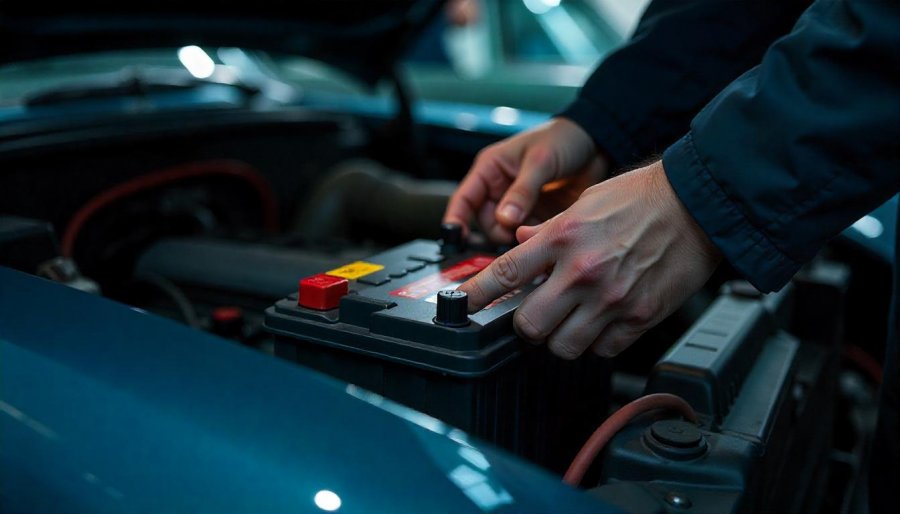A reliable vehicle begins with a healthy battery, yet many drivers overlook this vital component until a problem arises. Do you know that simple actions like inspecting terminals for corrosion, tightening connections, and testing voltage can dramatically extend your battery’s lifespan? The chemistry inside, influenced by temperature and vibrations, determines how well your battery performs over time. Small signs—slow starts, dimming lights, or flickering—may hint at deeper issues that, if caught early, can prevent unexpected breakdowns. Are you prepared to recognize these warning signals before they leave you stranded? Regular maintenance routines like cleaning terminals and monitoring key performance indicators turn routine checks into powerful safeguards against costly repairs and inconvenient failures. Mastering the art of battery care empowers you to enjoy stress-free driving and peace of mind, transforming a simple check into a critical step toward dependable, worry-free mobility.

Keep Your Car Ready with Essential Battery Maintenance Tips
A reliable car starts with a healthy battery, yet many drivers overlook this crucial component until a problem strikes. The battery is essentially the engine’s power station, providing the electrical energy needed to start the vehicle and keep its electronic systems running smoothly. Inside, lead plates—positive and negative—store energy through chemical reactions, with sulfuric acid acting as the electrolyte that facilitates the movement of ions. When everything is in good shape, this process ensures your car starts effortlessly, even on cold mornings, and that your lights and gadgets operate without a hitch.
Over time, however, internal wear and tear can compromise the battery’s performance. Heat accelerates chemical reactions that degrade the lead plates and electrolyte, while vibrations from uneven roads can loosen connections or cause internal damage. Age also plays a significant role, with most batteries lasting about three to five years. These factors often manifest as slow starts, dimming lights, or electronic glitches—small signs that your battery might be nearing the end of its life. Recognizing these early indicators allows you to act before a roadside breakdown leaves you stranded.
One of the simplest ways to keep your battery in top shape is by regularly inspecting the terminals for corrosion. White, bluish, or greenish deposits—caused by chemical reactions over time—can interfere with electrical flow. Cleaning these deposits with a mixture of baking soda and water is quick and effective, restoring proper contact. Ensuring the terminals are tightly connected is equally important, as loose connections can cause intermittent power loss, especially during startup or when running accessories. These straightforward checks can prevent many common starting issues and electronic malfunctions.
Testing your battery’s health with a multimeter is another simple step. When the engine is off, a healthy battery should read around 12.6 volts. If the voltage drops below 12.4 volts, it’s a sign that your battery is weakening and may need recharging or replacement soon. Regular voltage checks, especially before long trips or during extreme weather, help you catch potential problems early. Addressing these signs promptly can save you from unexpected breakdowns and costly repairs, keeping your vehicle dependable in everyday driving.
By staying proactive with basic maintenance, you can extend your battery’s lifespan and ensure your vehicle is always ready to go. Simple routines like visual inspections for corrosion, tightening connections, and voltage testing don’t require special skills or tools. Incorporating these into your regular car care—every few months or before winter and summer—can make a significant difference. These small habits help you identify issues early, prevent breakdowns, and enjoy worry-free driving, no matter the weather or road conditions. A little attention now pays off with reliable starts and smooth operation whenever you need your car most.

Unlock the Secrets of Car Battery Care and Longevity
Understanding how a car battery functions is fundamental to maintaining its health. At its core, a typical automotive battery provides the electrical energy needed to start the engine and power the vehicle’s electronic systems. Inside, lead plates—positive and negative—store energy through chemical reactions, while sulfuric acid acts as the electrolyte, facilitating ion flow between these plates. When functioning properly, this process produces the current necessary for the starter motor and all your electronic accessories to operate seamlessly. Recognizing these basic components helps you appreciate why keeping the battery in good shape is so vital for reliable driving.
Over time, internal wear and external factors can compromise a battery’s performance. Heat accelerates chemical reactions inside the battery, leading to faster degradation of the lead plates and electrolyte breakdown. Vibration from rough roads can loosen internal connections or cause damage, while age naturally reduces the battery’s ability to hold a charge. These issues often show up as slow engine starts, dimming lights, or intermittent electronic glitches—small signs that your battery is nearing the end of its lifespan. Being aware of these signs allows you to intervene early, preventing inconvenient breakdowns.
Corrosion on the terminals is one of the most common problems affecting battery performance. This appears as a white, bluish, or greenish powdery buildup that can obstruct electrical contact. Such corrosion results from chemical reactions involving sulfuric acid and moisture, especially if the battery isn’t cleaned regularly or the vehicle is exposed to humid conditions. Cleaning the terminals with a simple mixture of baking soda and water is effective and quick, restoring proper contact. Keeping the terminals tight also prevents loose connections that can cause starting issues or flickering lights during your drive.
Testing your battery’s health is straightforward and can be done with a basic multimeter. When the engine is off, a healthy battery should read around 12.6 volts. If your measurement drops below 12.4 volts, it indicates the battery is weakening and may need recharging or replacement soon. Regular voltage checks, especially before long trips or during extreme weather, help catch early signs of deterioration. Acting promptly on these signals can save you from unexpected breakdowns, roadside emergencies, and costly repairs, keeping your vehicle dependable.
Temperature plays a significant role in how well your battery performs. Heat speeds up internal chemical reactions, which can shorten the lifespan of the battery by causing internal components to degrade faster. Cold weather reduces the battery’s capacity to deliver power, making it harder to start your vehicle during winter. Vibration from uneven roads can loosen internal connections or cause damage that affects performance. Most batteries last between three and five years, but exposure to extreme conditions can shorten that window. Understanding these influences allows you to take preventive steps, such as parking in shaded areas or avoiding unnecessary short trips that don’t give the battery a chance to recharge.
Simple maintenance routines can significantly extend your battery’s lifespan and ensure your vehicle remains reliable. Regularly inspecting the terminals for corrosion, tightening connections, and testing voltage are quick checks that can be done at home or during routine service. These small steps help identify issues early—before they turn into roadside failures. Making them part of your routine, every few months or seasonally, builds a habit that keeps your battery healthy and your vehicle ready for whatever lies ahead. By understanding and caring for the core aspects of your battery, you set yourself up for worry-free driving and peace of mind on the road.

Simple Steps to Routinely Check and Maintain Your Battery’s Health
Performing routine checks on your car battery is straightforward and doesn’t require any advanced skills or special tools. Start by opening the hood and inspecting the battery terminals. Look for any signs of corrosion—those white, bluish, or greenish deposits that can build up over time. Corrosion can interfere with the flow of electricity, leading to starting problems or flickering lights. If you notice any buildup, mix a little baking soda with water, then use an old toothbrush or small brush to gently scrub away the deposits. Wipe the terminals clean with a damp cloth afterward, and make sure they’re tightly connected to prevent any loose contact that could cause intermittent issues.
Next, test your battery’s health with a multimeter. Set the device to measure DC volts, then place the red probe on the positive terminal and the black probe on the negative. With the engine off, a fully charged battery should read around 12.6 volts. If your reading dips below 12.4 volts, it’s a sign that your battery is weakening and may need recharging or replacing soon. Regular voltage checks, especially before long trips or during extreme weather conditions, help you spot potential problems early—before they turn into roadside emergencies. Performing this check takes just a few minutes but can save you from unexpected breakdowns and costly repairs.
Listening to how your vehicle starts can also provide useful clues. If the engine cranks slowly, takes longer than usual to turn over, or if you notice dimming headlights and flickering dashboard lights, these are signs your battery might be on its last legs. In such cases, a quick voltage test or professional assessment can confirm whether it’s time for a new battery. Addressing these symptoms early keeps your vehicle dependable and reduces the risk of being stranded unexpectedly.
Physical inspection remains a key step. Carefully look for any swelling, cracks, or leaks around the battery case. Swelling or leaks indicate internal damage, often caused by exposure to extreme temperatures or aging. If you notice these signs, replace the battery promptly. Don’t ignore physical damage—these issues can lead to dangerous leaks or sudden failures, leaving you stranded or risking damage to other engine components. Regular visual checks are quick and simple but crucial for maintaining safety and reliability.
Incorporating these checks into your routine maintenance takes only a few minutes every few months. Keep a small bottle of baking soda, a brush, and a multimeter in your garage or glove compartment. These basic tools make it easy to perform quick inspections at home or during routine service visits. Doing so consistently helps you catch early signs of wear and tear, allowing for timely intervention. Over time, these simple steps become second nature, helping you stay ahead of potential problems and ensuring your vehicle remains dependable.
Notice how your car responds during startup. Slow cranking or difficulty starting can signal that your battery is losing its capacity. Dimming or flickering lights while driving also point to electrical issues linked to battery health. Don’t dismiss these signs—they’re often the first hints that your battery needs attention. Addressing them early can prevent inconvenient breakdowns and costly repairs, keeping your daily routine on track. Regularly monitoring how your vehicle starts and performs is a practical way to stay in tune with your battery’s health.
Taking these straightforward steps ensures your battery stays in good shape and your vehicle remains reliable. A quick visual inspection, a simple voltage test, and paying attention to startup behavior form a solid foundation for proactive maintenance. This approach not only prevents unexpected stalls but also extends your battery’s lifespan, saving you money over time. By making these checks a regular habit, you develop a better understanding of your car’s needs and build confidence in its dependability.
Ultimately, caring for your battery isn’t just about avoiding breakdowns—it’s about peace of mind. With a few simple routines, you can keep your vehicle running smoothly and reliably when it matters most. These small actions help you stay one step ahead, ensuring your car starts confidently, your electronics stay powered, and you avoid unnecessary stress. Routine battery checks are a hassle-free way to protect your investment and enjoy worry-free driving every day.
Performing these regular checks can significantly extend the lifespan of your battery and prevent unexpected failures. For more detailed guidance on maintaining your vehicle’s electrical system, you can visit this comprehensive battery maintenance guide. Staying informed and proactive ensures your car remains dependable in all conditions.






